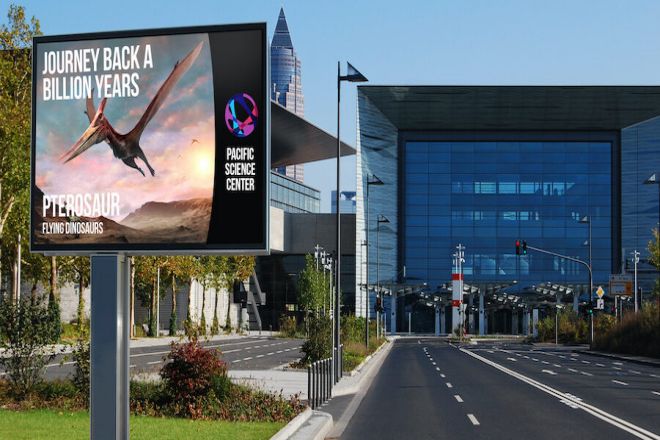Introduction

In the wave of digitalization and informatization, LED digital cards, with their unique advantages, are gradually becoming an important carrier of information dissemination in modern society.
As an intelligent device integrating display, control, and information dissemination, LED digital display not only enriches people’s visual experience but also greatly improves the efficiency and accuracy of information transmission. The emergence of LED digital cards is the product of the combination of scientific and technological progress and social needs.
1. Introduction to LED digital signage
LED digital signage is an electronic display board made of LED (light-emitting diode). LEDs are like small light bulbs that can emit light. Many of these small light bulbs can display numbers, letters, pictures, or videos.
The advantage of this sign is that it has high brightness, bright color, and a clear view. Moreover, LEDs have a long lifespan and will not break down as easily as traditional light bulbs. More importantly, it is very energy-saving and will not waste too much electricity.
LED digital signage can be seen in many places. For example, in shopping malls, supermarkets, hotels, and other places, they can be used to display advertisements, special offers, or navigation instructions. At traffic intersections, they can be used to tell people how to go. In sports venues, they can show game scores or timing.
Nowadays, LED digital signage is becoming more and more advanced. You can change the displayed content through a remote control, and you can also connect to the Internet to update information in real time. Therefore, LED digital signage is not only good-looking but also very practical, which brings a lot of convenience to our lives.
2. What is the difference between the cost of LED digital signage systems and traditional signage solutions?

Comparison of the cost of LED digital signage system and traditional signage
First of all, let’s briefly understand why the LED digital signage system is different from traditional signage.
Traditional signs are common signs made of paper, plastic, or other materials with words or patterns. They are usually used in stores, offices, or public places to display information or advertise.
The LED digital signage system is electronic signage made using LED (light-emitting diode) display technology. This kind of signage can display not only text and patterns but also dynamic videos or pictures. Moreover, its content can be updated remotely through the network at any time, which is very convenient.
So, what is the difference in cost between the 2 ?
- Initial investment cost
The initial investment cost of traditional signs is relatively low. You only need to buy materials and pay the production cost, and then you may need some installation costs. The whole process is relatively simple, and the cost is relatively fixed.
The initial investment cost of an LED digital signage system is relatively high. Because it includes not only the cost of the display but also the cost of the control system, power supply, installation, and possible network connection. Moreover, in order to ensure the display effect and quality, you may need to choose higher-quality components, which also increases the cost.
- Maintenance costs
For traditional signs, if you need to change the content, you usually need to remake the signage, which involves re-purchasing materials, paying production costs, etc. If the signage is damaged or aging, it also needs to be replaced or repaired, which will incur additional maintenance costs.
The maintenance cost of the LED digital signage system is relatively low. Because you can update content remotely through the network, you don’t need to change physical signs frequently. Moreover, the life of the LED display is usually long, and it is not easy to damage.
Of course, if there is a technical failure or the need to upgrade the system, there may also be certain maintenance costs, but these costs are usually less than traditional signs.
- Long-term cost-effectiveness
Although the initial investment cost of an LED digital signage system is relatively high, it is usually more cost-effective in the long run.
Because it can update content flexibly and quickly, which is very important for business promotion and information dissemination; moreover, due to the reduced cost of maintenance and replacement, the overall cost will gradually decrease over time.
3. What are the main benefits of using LED digital signage to enterprises and organizations?
The use of LED digital signage has brought many benefits to enterprises and organizations. Here are some of the main advantages:
- Improve brand image and public awareness:
The high brightness and clear picture quality of LED digital signage can attract people’s attention, thus effectively transmitting the information of enterprises or organizations. This modern display method helps to enhance the brand image of the enterprise, make it more compatible with the public image, and thus enhance the public’s awareness and memory of the enterprise.
- Flexible information display and update:
The content of LED digital signage can be updated in real-time. Whether it is text, pictures, or videos, it can be quickly replaced as needed. This enables enterprises to flexibly display the required information according to different occasions, times, and needs and improve the efficiency of information dissemination.
- Enhance interaction and communication with customers:
LED digital signage can act as an additional salesperson or customer service representative to interact with customers. Through the dynamic and vivid display of content, digital signage can attract the attention of customers and increase their interest in products or services, thus increasing sales opportunities.
- Improve marketing effect and advertising revenue:
LED digital signage can help enterprises stand out in a competitive business environment and improve marketing effect. At the same time, for some application places, such as large shopping malls, digital signage can also bring additional advertising benefits to enterprises. By renting to suppliers by time and location, enterprises can not only improve product sales and brand awareness but also enhance their popularity.
- Expand the “inventory” of retail outlets:
In the retail industry, LED digital signage can expand the “inventory” of retail outlets. Through a unified digital signage network, retailers can display their full range of products at each retail point, allowing customers to shop flexibly, thus improving sales efficiency.
- Energy saving, environmental protection, and cost-effectiveness:
LED digital signage usually has the characteristics of energy saving and power saving, low power consumption, and low operating cost. At the same time, due to its long service life, the maintenance cost is relatively low. This makes LED digital signage an environmentally friendly and economical choice.
4. What type of content is most suitable for LED digital signage?

LED digital signage is characterized by flexibility, high brightness, and ease of updating, enabling it to display multiple types of content. Here are some content types that are most suitable for display with LED digital signage:
- Dynamic advertising and promotional information:
The high brightness and dynamic effect of LED digital signage make it an ideal choice for displaying advertising and promotional information. By circulating attractive videos, animations, or pictures, digital signage can effectively attract the attention of customers and improve the exposure of products or services.
- Real-time information and news updates:
Digital signage can update information in real time, which is very suitable for displaying the latest news, weather, traffic, and other information. This is especially practical for public places that need to update information at any time, such as airports, railway stations, shopping malls, etc.
- Brand logo and image display:
LED digital signage can be used to display the brand logo, slogan, or image video of an enterprise to help improve brand awareness and image. Through a unified visual style and design, digital signage can strengthen the brand impression and improve customers’ awareness of the brand.
- Guide and instruction information:
In large buildings, shopping malls, or exhibitions, LED digital signage can be used as a touring tool to provide floor distribution, store location, exhibit introduction, and other instruction information. This helps customers find their destination more conveniently and improve the efficiency of the place.
- Public information and notices:
Digital signage can also be used to publish public information, such as meeting notices, safety tips, emergency evacuation instructions, etc. In emergency situations, digital signage can quickly update information and guide people to take appropriate action.
- Entertainment content and interactive experience:
LED digital signage can also be used to display entertainment content, such as music videos, movie trailers, etc., to add atmosphere to the venue. At the same time, through the interactive function, digital signage can also provide interactive experiences such as games and lucky draws to attract the participation and interest of customers.
5. What are the technical requirements for using LED digital signage?

The operation of LED digital signage involves a series of technical requirements to ensure its normal operation and effective display of content. Here are some key technical requirements:
- Proficient in content editing software:
You need special software to produce and edit what you want to display. This software is like a drawing board and editor on which you can write, draw pictures, or add videos. After editing, you can save this content for digital signage.
Familiar with network transmission protocols:
In order for digital signage to display your edited content, you need to transmit the content to digital signage through the Internet. It’s like sending files on your computer to another computer or TV. Such as TCP/IP, HTTP, etc., to ensure the accurate transmission and synchronous update of content.
- Understand the hardware interface and configuration:
LED digital signage involves a variety of hardware devices, such as display screens, controllers, power supplies, etc. You need to understand the interface types and configuration requirements of these devices in order to connect and set them up correctly to ensure compatibility and stability between hardware.
- Master debugging and maintenance skills:
LED digital signage may encounter various problems during use, such as display failure, network interruption, etc. You need to have certain debugging and maintenance skills to quickly locate and repair problems and ensure the continuous and stable operation of digital signage.
- Comply with safety regulations:
When operating LED digital signage, it is necessary to comply with relevant safety regulations, such as preventing electric shock, fire prevention, etc. At the same time, for content involving sensitive information, it is also necessary to ensure the security and privacy of data.
In addition, with the continuous development of technology, the function and performance of LED digital signage are also constantly improving.
You need to pay attention to the development of new technologies and applications and constantly learn and update your knowledge system to adapt to the changing market demand and technological environment.
Conclusion
The above is all the content of this article. Do you have any new understanding of LED digital signage? If you want to know more about digital signage, please get in touch with us.
